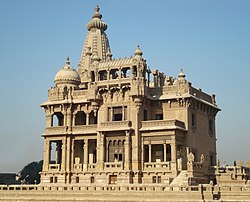Alexandre Marcel
Appearance
You can help expand this article with text translated from the corresponding article in French. (July 2016) Click [show] for important translation instructions.
|
Alexandre Marcel | |
|---|---|
| Born | September 11, 1860 |
| Died | June 30, 1928 (aged 67) |
| Occupation | Architect |


Alexandre Marcel (11 September 1860 - 30 June 1928) was a French architect, best known for his Belle Époque interpretations of "exotic" international architectural styles.
Marcel studied at the Parisian École des Beaux-Arts in the atelier of Louis-Jules André.
Works
[edit]His work includes:
- the Pagoda Cinema, on the Rue de Babylon, Paris, 1896
- multiple buildings for the Paris Exposition of 1900, including the Cambodian pavilion and the Panorama du Tour du Monde of the sea-transport company Compagnie des messageries maritimes with its "Japanese Tower"
- structures at the Parc Oriental de Maulévrier, Paris, 1899-1913
- reconstruction of the Japanese Tower at Laeken, outside Brussels, for King Leopold II, c. 1901
- the new Chinese Pavilion at Laeken, for Leopold II, c. 1902
- royal racetrack at Ostend, for Leopold II[1]
- grand hall of the Heliopolis Palace Hotel, Heliopolis, Cairo, 1910
- Baron Empain Palace (Qasr Al Baron), Heliopolis, Cairo, completed 1911
- Latin Catholic Basilica "Basilique de Notre-Dame", Heliopolis, Cairo, 1910
- Palace for the Jagatjit Singh of Kapurthala, now Punjab, India, 1911
- French Embassy, Shiba Park, Tokyo, 1913
- Lafayette Escadrille Memorial, Villeneuve-l'Étang Imperial Estate, in Marnes-la-Coquette, Hauts-de-Seine, outside of Paris, 1928
Sources
[edit]References
[edit]- ^ Alexandre Marcel Archived 2012-03-04 at the Wayback Machine @ the Parc Oriental de Maulévrier website.
Wikimedia Commons has media related to Alexandre Marcel.
